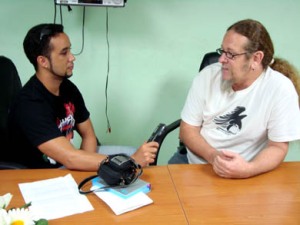 Just a few hours ago, on Friday evening, the 30th, one of the most versatile of Cuban artists exhibited material in the United States that could make history. I am speaking of Edesio Alejandro, who although a musician of great importance, has also been known for a long time as a documentary film maker.
Just a few hours ago, on Friday evening, the 30th, one of the most versatile of Cuban artists exhibited material in the United States that could make history. I am speaking of Edesio Alejandro, who although a musician of great importance, has also been known for a long time as a documentary film maker.
The present material is titled 100 Cuban Sounds, and according to critics and viewers, the return of his inquisitive eye to our rhythm marks a milestone of investigation and artistry.
The beauty, and the irony, is that it is Edesio, a rarity in Cuban culture, who has been carrying on his back this precious company so dear to our nation. He is the Cuban author with the greatest number of movie soundtracks in this country, which puts him, musically, in the same category as classics of our filmography such as Clandestinos, and the aching Suite Habana, both by Fernando Pérez.
Why? Well, because if any of Cuba’s Culture authorities in the ‘70s and ‘80s had been told that this youngster with the controversial image, who had to be very careful, would be one of the archaeologists of our musical identity, he’d probably have replied with a withering smirk.
I think of this, ironically, after rereading the report of a meeting that, fortunately, a journalist had with his some time ago. In my city of Bayamo, 496 years after its founding, Edesio revealed to me some of the keys of his professional history on the Island.
I reproduce a small fragment of this dialog, which I think quite compelling in two respects: First, to understand the origin of those 100 Cuban Sounds in the artistic perspective of this great man; and second, to “Hear his voice,” whose risk-taking could be the path of an authentic artist in our Cuban of parameters:
– Edesio, you started out as a pure rocker. Then you started to make electronic music, but you had already begun composing, including concert music. Today you are entering the audiovisual world with great strength. Does it worry you that this variety could be interpreted as an artist that hasn’t really found his specific line of work?
– Well, look, no. Not in the least. I’m not worried because I think that the day I remain static is when I will have lost all the evolution that I have managed in my career. I think the evolution is something that is in constant searching, constant experimentation.
When I find a formula, I try to flee from it, as absurd as that might seem, because with this formula I would establish standards and rules which I will then repeat, and the day when I begin to repeat myself I will no longer feel I am creating.
My personality is that of a rather restless guy. In this I think I am a typical Cuban. I like to be constantly changing, and that’s the reason why my works are all so different.
– One of the standard references of electroacoustic music in Cuba is undoubtedly Edesio Alejandro. The majority of experts agree that you have an enormous talent for this type of work. But in the end you didn’t dedicate yourself to this, when it seemed it would be your path. To what do you attribute this?
– As it turned out, in the ‘80s, when I was working the most on this, I decided to participate in a contest that at that time was the most important in the world for electroacoustic music. It took place in Bourges, France. Let’s be clear, this was seen by many as madness.
And then I won First Prize with a work I did with Juan Piñera, a composer with whom I had worked on concert music. You can imagine, this was an incredible thing.
What did it mean for me? Reaching a ceiling, achieving a status that until this time no Cuban musician had achieved within this kind of artistic work, because it was the first time that a Cuban (before or after the Revolution) had won the First Prize in a global music contest.
Then came the disappointed. The prize was greeted with almost total silence in Cuba, its achievement, which was no small thing, was ignored by the media and by the cultural authorities, to the extreme that we were not allowed to go to France to receive the prize. Their excuse was that I was “one of those guys with long hair who walks around in a T-shirt trying to pass for a foreigner,” and that I was of “questionable political reliability.”
I don’t have to tell you… it was a tremendous frustration. Think about it: on the one hand being so young and having won a prize like this made me feel like I’d touched the sky, and on the other to have cold water poured on me, to begin to be marginalized in part because of it, and in Cuba, to be treated like shit.
I said then, “This isn’t for me.” I started to do many more things and I will continue to.
– Your 1987 work Violent, is considered the first Latin American rock opera. And yet it is a complete unknown in Cuba. Why is it that most of your work can be enjoyed only in very narrow circles when so many are interested in it?
– Look, they never wanted me to record in Cuba. This is a truth that I can say without further ado. Like so many other things, Violent ended up in the ether. The music needed to be recorded to be preserved, but on the contrary, it was vaporized. But the Cuban industry never wanted me to record.
For example, this same Violent you are asking me about premiered at the National Theater of Cuba; but at EGREM, which then was the only recording company in the country, I asked them again and again to record it but they weren’t interested.
What did I do then? I worked in radio, in music for TV, in film, I “stole” a few hours at the end of each movie or each serial to devote to something that particularly interested me. I say stole because that’s literally what I did; I used some of the production to record my songs, which, by the way, were very badly recorded because in four or five hours you can’t record three songs.
On several occasions I proposed to EGREM that they make records, and they always gave the answer: we’re not interested. All this is long ago.
Currently, it’s true that EGREM has made proposals to me several times, but now it’s me who doesn’t want to do it. Thank God I have other options with other labels, so fortunately not all of my music has suffered the same fate as that you asked me about.




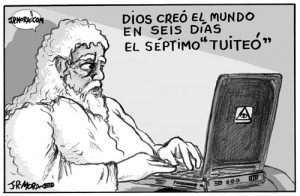
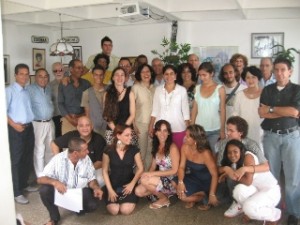 Last month, Yoani Sanchez, the creator of Generation Y, invited some of her friends to contribute to the diffusion of micro-blogging through the group known as “The First Tweet-up on the Island.” In regards to such a meeting, I asked when and where.
Last month, Yoani Sanchez, the creator of Generation Y, invited some of her friends to contribute to the diffusion of micro-blogging through the group known as “The First Tweet-up on the Island.” In regards to such a meeting, I asked when and where.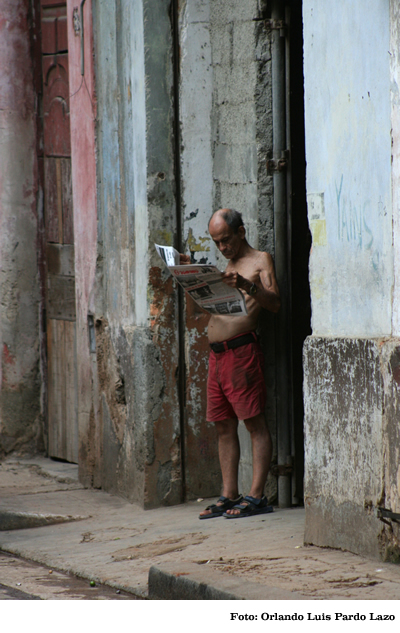



 Omar, the lens for the word (Photo: Luis Felipe Rojas)
Omar, the lens for the word (Photo: Luis Felipe Rojas) Just a few hours ago, on Friday evening, the 30th, one of the most versatile of Cuban artists exhibited material in the United States that could make history. I am speaking of Edesio Alejandro, who although a musician of great importance, has also been known for a long time as a documentary film maker.
Just a few hours ago, on Friday evening, the 30th, one of the most versatile of Cuban artists exhibited material in the United States that could make history. I am speaking of Edesio Alejandro, who although a musician of great importance, has also been known for a long time as a documentary film maker.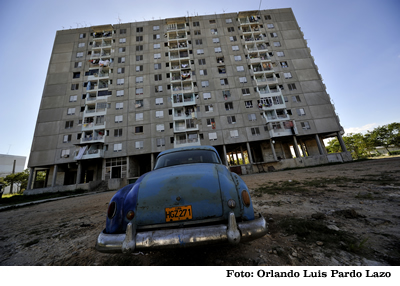
 Amidst Cuban flags, famous boleros, and white flowers, thousands of exiles and hundreds of Latin Americans bid farewell to Olga Guillot on Monday, July 12th. On Friday Guillot checked in to the Mount Sinai Hospital in Miami, that city where she lived in and occasionally performed ever since the 60’s, although Venezuela and Mexico were her first sanctuaries after leaving Cuba in 1961, while her voice still filled all the radios of the country.
Amidst Cuban flags, famous boleros, and white flowers, thousands of exiles and hundreds of Latin Americans bid farewell to Olga Guillot on Monday, July 12th. On Friday Guillot checked in to the Mount Sinai Hospital in Miami, that city where she lived in and occasionally performed ever since the 60’s, although Venezuela and Mexico were her first sanctuaries after leaving Cuba in 1961, while her voice still filled all the radios of the country.